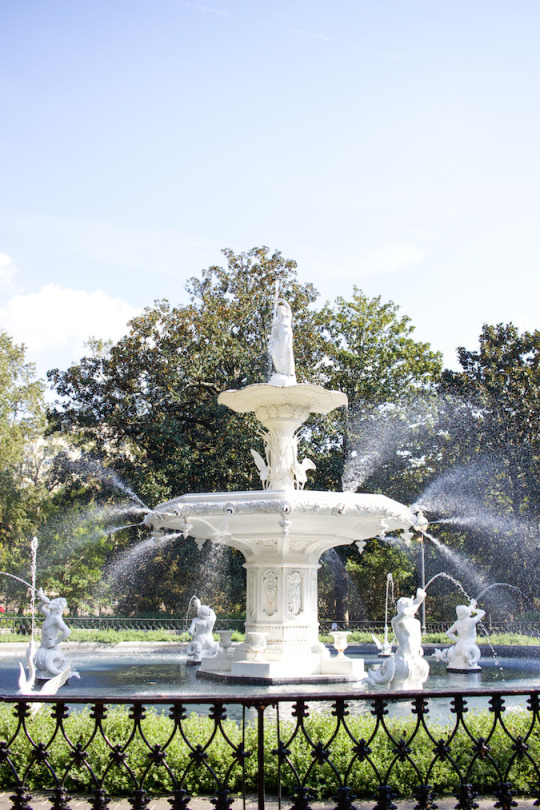#forsyth park
Explore tagged Tumblr posts
Photo

The beautiful Forsyth Park fountain in Savannah, GA
39 notes
·
View notes
Text



















Reconstruction Era of the United States: Georgia became the last of the former Confederate states to be readmitted to the Union on July 15, 1870.
#Georgia#readmitted#15 July 1870#USA#travel#original photography#vacation#tourist attraction#landmark#cityscape#architecture#landscape#summer 2016#Colonial Park Cemetery#Savannah#Augusta Cotton Exchange#Martin Luther King Jr. National Historical Park#Atlanta#Calhoun City Park#Centennial Olympic Park#Forsyth Park#Savannah River#Augusta
4 notes
·
View notes
Text
Visiting my alma mater this weekend with the family, attending an event I used to participate in back when I had good knees

Tracy Yardley and @tysonhesse are also SCAD grads, I wonder if they ever come down for the Sidewalk Arts Festival?

Anyway, if I see anything interesting, I'll share some pix over on @taffydrag0n
#scad#savannah college of art and design#scad sidewalk arts festival#sidewalk arts festival#sidewalk art#sidewalk chalk#forsyth park#savannah ga#sonic the hedgehog fanart#sth#sonic#naoto ohshima#sonic the hedgehog#sonic cd#metal sonic#doctor eggman#eggman
12 notes
·
View notes
Text

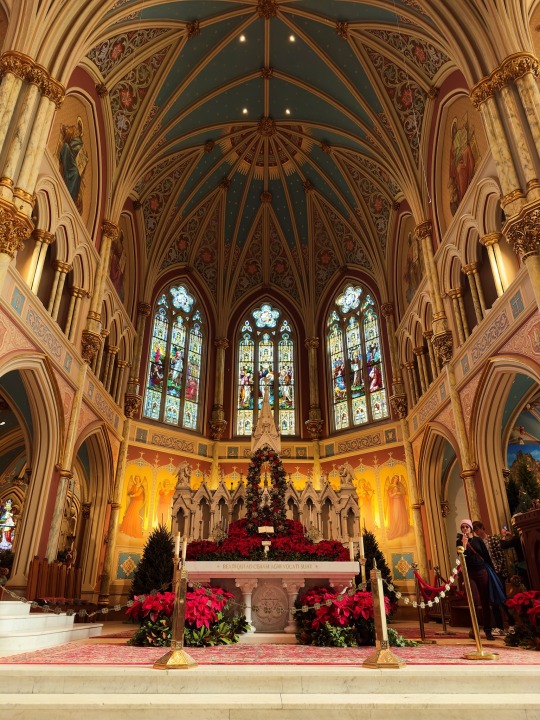






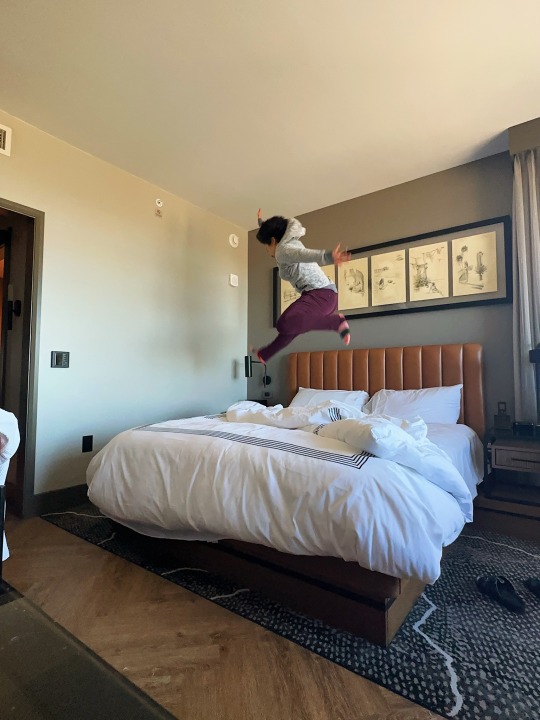
things and thangs savannah december 2022 photo dump
#snapshots and borrowed thoughts#photographers on tumblr#savannah#forsyth park#cathedral basilica of st john the baptist#jw marriott#thompson savannah#fleeting savannah#stevedore bakery#photo dump#december 2022
4 notes
·
View notes
Text
Exploring Savannah: Affordable Adventures Await
Savannah Are you looking for an affordable and exciting getaway? Look no further than the charming city of Savannah, Georgia. Known for its southern hospitality, rich history, and mesmerizing beauty, Savannah offers many adventures at affordable prices. Whether you’re traveling as a family, couple, or solo, there is something for everyone in this vibrant city. The Historic District One of the…

View On WordPress
1 note
·
View note
Text

Two old friends chillin in Forsyth park. 🍀☘️🟠⚪️🟢
#savannah ga#savannah georgia#savannah#forsyth park#street photografie#street photography#street photoshoot#happy st paddys day#happy saint patricks day#happy st pattys day#st paddys day#leprechaun#shamrock#kiss me I’m irish#Irish#saint paddys#saint patricks day#saint paddys day#happy st patricks day#celticsnation#celtic#old friends#bff#green dye#street photographer#saint patrick’s day#saint Patrick’s day 2023#saint Patrick’s day parade#shamrocks#shenanigans
1 note
·
View note
Text
Feeling ethereal
0 notes
Text
The State Birds Initiative: Georgia (#4)
Welcome to the fourth official poll of the State Birds Initiative! Before the poll, though, one thing real quick. My suggestion is that you read the post below before voting in the poll below. That's especially important if you're lacking any context about the birds being presented as the new (or old) State Bird of the Peach State, Georgia. This is to be fully informed as to why these are being presented, and to make your choices appropriately. Lastly, some of these birds, you will notice, may go against some of the rules listed in the introduction post. All is explained after the jump where the explanations are, I promise you that. But with that...OK! Here's the poll!
With that...time to put Georgia on our minds!

Georgia! State of peaches, Coca-Cola, pecans, and civil rights! Home of Ray Charles, Jimmy Carter, Jackie Robinson, and the great Martin Luther King, Jr.! Location of the only whale shark in captivity in the country, the historic Forsyth Park of Savannah, the majestic Stone Mountain, and the first Chick-fil-A! And for our purposes here in the State Bird Initiative, it's also the first state we're looking at with a tropical climate! Well, a humid subtropical climate, actually, but it counts! If you've ever been to Georgia (which I haven't as of yet, but I'm working on that), you probably know that Georgia is a bit sweaty and temperate most of the year, with long humid summers and high water levels.
In terms of the ecology of the state, we're looking at swamps, cedar-dominated, as well as having a decent proportion of pine trees. Actually, to be specific, we're looking at forests of Longleaf Pine (Pinus palustris), an large endangered pine tree species endemic to the southeastern United States. Now, to be clear, this species isn't specific to Georgia, and it's actually the state tree of Alabama. However, now that we've hit the southern USA, we have to address it, as the tree is a symbol of the region. The actual state tree of Georgia is another iconic tree to the southeastern USA, the Southern Live Oak (Quercus virginiana), another big tree evolved to be resistant to forest fires, saltwater, and hurricane-force winds common in the area. Famously, the Southern Live Oak trees of St. Simons Island, Georgia was harvested for the density of their wood, which made them particularly strong against cannonballs. Said wood was used to construct the famous U.S.S. Constitution, AKA "Old Ironsides", which was said to have cannonballs actually bounce off of it throughout the War of 1812. Said ship is still in Boston Harbor to this day, making the 227-year old ship the oldest still floating naval warship in the world! And that's all thanks to the natural environment of Georgia.

What about Georgia's culture? Historically, of course, Georgia is complicated as hell. A former seat of the Civil War and the Confederacy, the state has seen heavy reconstruction in the last century and a half, eventually becoming associated with many civil rights heroes, and currently having a few prominent bastions of the Democratic Party, such as Atlanta. On a contemporary level, the state is famous for its music, its accents, and its food! The state has at least four foods as state symbols - peaches, peanuts, grits, and the Vidalia onion, and has other iconic food and drink like sweet tea, cornbread, peach cobbler, and fried catfish.
As for its people, they're a highly religious bunch on average, known for their hospitality and, according to some accounts online, "polite sarcasm". Y'know, "bless your heart" and all that. Conservative historically with an increasing population of Black Democrats in metropolitan centers, it's a growing state in terms of diversity, and changing rapidly. So...a culturally diverse bird that lives in oak trees? Yeah, that's a target we're gonna hit for sure. I mean, the oak or pine tree part is pretty easy, but the other thing? Well..a songbird would make some sense. I mean, the state is famous for its musicians, ranging from OutKast to Gladys Knight to 2 Chainz to Luke Bryan, and more. So, something that sings is a solid choice. There are a couple of other qualities we can go for, but that's enough for now, I think.

With that, let's move onto the choices. Got some interesting ones this time, but I have...a hunch about this one. We'll see how this goes, but I have a feeling it's gonna go the way of New Jersey's poll, which has been...decisive. But OK, with that...birds after the jump!!!
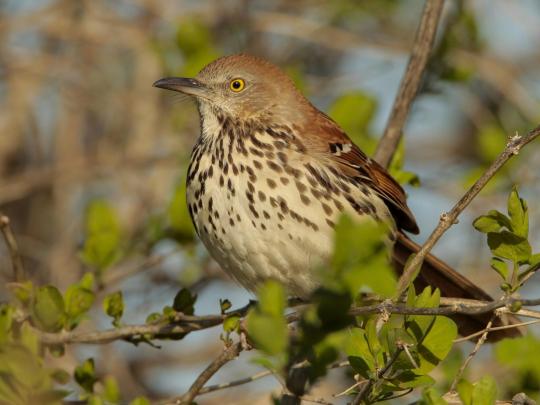
Brown Thrasher (Toxostoma rufum)
Not gonna lie - this one could be hard to beat, surprisingly. Which is too bad for a number of reasons, but the Brown Thrasher (Toxostoma rufum) isn't really a horrible choice for Georgia's State Bird. It breeds in the state, even though it's found all over the eastern and central USA. It's an iconic bird in sight and sound, which is pretty important for a state that's produced a lot of human singers. I even mentioned up above that a songbird wouldn't be a bad choice, and what better songbird than one who can memorize, mimic, and remix multiple sounds for its own use? Plus, it was chosen by school kids, meaning it was elected by the public. Of course, to be fair, it was also chosen by governor at the time, Eugene Talmadge, a famous white supremacist who enforced segregation in Georgia schools and universities, openly supported Adolf Hitler, and was a genuinely extremely racist PIECE OF SHIT...but I digress? Although, it is extremely ironic that Talmadge ratified the Brown Thrasher as the State Bird of Georgia, so there's that.
OK, Talmadge doesn't really have anything to do with this, I just needed to get some anti-racist anger out for a second there, sorry; dude was a bastard in a lot of ways. But in terms of the Brown Thrasher, it's honestly not a bad choice for Georgia. Thing is...I'm not entirely sure I can say it's the best choice, or even a really good choice, frankly. It's...a choice. It does eat peaches, though, so maybe throw that into the pros pile for the species. Oh, and one more thing: it's defeated an attempt to depose it before. The frankly kinda ridiculous attempt to change the State Bird of Georgia to the Cornish Chicken in 2010 was not received well for the chicken. Georgians liked their Thrasher too much! Also, one of the arguments against the Brown Thrasher that the Flip the Bird movement put forth was that it "has no contribution to the state of Georgia economy". Of all the stupid goddamn arguments...
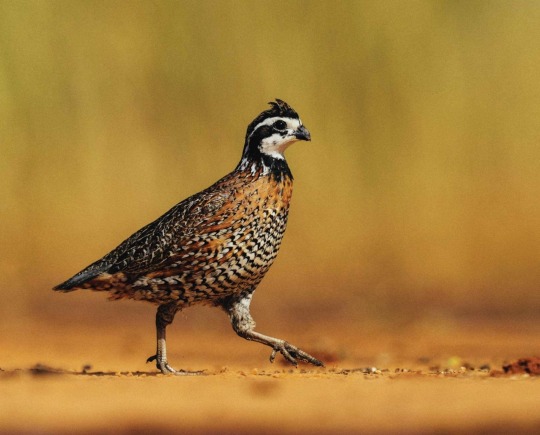
Northern Bobwhite (Colnius virginianus)
Well, if we're talking about the incumbent State Bird, we should bring up the incumbent State Game Bird as well! Yeah, this'll be a regular thing going forward. Any ornithological state symbols are up for bid and re-election, although this is a slightly different process. If a State Game Bird is elected as State Bird, it will ascend to that post, and a new State Game Bird will be proposed, possibly with a new poll. However, if it is not the chosen State Bird, it'll remain as the State Game Bird. So, really, the Northern Bobwhite gets to stay where it is...for now. This may change as we get overlapping game birds across the USA. And we will, believe me. With that said, let's talk about the Northern Bobwhite (Colinus virginianus).
A member of the New World quails (Odontophoridae) the bobwhite is named after its iconic whistling call, and not a random dude named Robert White. The Northern Bobwhite isn't the only species of bobwhite quail by any means, but it's the only major native representative in the USA. It's a grassland and open forest-loving quail whose range extends from Texas to Massachusetts...kind of. Here's the problem with the bobwhite: its population is rapidly decreasing. In the past 60 years or so, the population's decreased by at least 85% in its native range, which is...A LOT. It's partially for that reason that the species is on my priorities for my Life List, because I've never seen them, and they're rapidly vanishing.
youtube
That, alongside the normal ecological concerns and links, and its relatively new status as a threatened species due to land use and forest fires, makes it a good candidate for recognition on its own. But is it a good bird for Georgia? Well, only 4% of its breeding population is found in the state year-round, making the state a poor reservoir for the species. There's also a point that the bobwhite is, surprisingly, an invasive species in some countries, specifically New Zealand and Italy. They're also a common bird in captivity, even though any aviary should have them be the only ground-dwelling bird, since they can be aggressive to competitors. That said, they're not a completely doomed species.
More importantly, though, the fact that Georgia doesn't have a lot of these guys immediately makes them a less-than-ideal candidate for State Bird. State Game Bird, though? That might actually be worse. Remember, this is an endangered species, meaning it may not be a bird we should glorify as a food source. In fact, the Georgia Department of Natural Resources has conservation measures in place to protect bobwhite and their habitat, also seeking to restore it and add new potential habitats for the species. And they aren't eliminating hunting of the species, but are strictly managing and monitoring populations. And there is merit to managed hunting, for the record, but that's a separate conversation to be had. So, not a horrible choice to remain as Game Bird. But who knows? Maybe I'll make a separate poll to ask this question after all. If that's something that interests you, let me know! For now, let's move on.
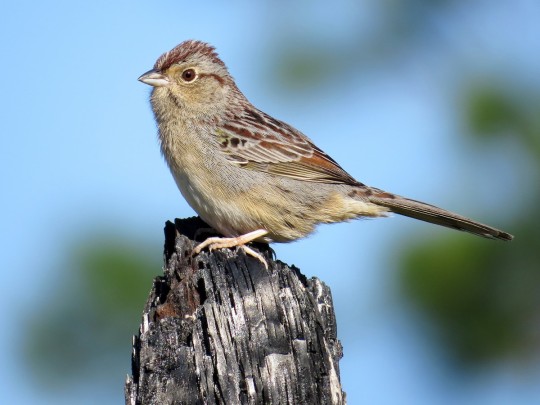
Bachman's Sparrow (Peuacea aestivalis)
On to the eBird suggestion! And this one is...ooooooooh...yikes. OK, yeah, you may remember my issue with the Saltmarsh Sparrow (Ammospiza caudacutus) as a potential State Bird for New Jersey, mostly revolving around the idea that it wouldn't be easily recognizable by the public, unaffiliated with sparrows and their subtle or major differences. This? This is worse. Once again, don't get me wrong, Bachman's Sparrow (Peuacea aestivalis) would be a dream for me as a birder, as a southern exclusive species and a lifer for me personally. But for the average layman? This is a bird difficult to identify for birders! Not sure the average non-bird person has a chance, to be honest.
But just to be completely comprehensive, why the Bachman's Sparrow? Well, the eBird article quotes the species as having a large breeding population in Georgia. However, to be completely fair, the species mostly breeds in Florida, not Georgia (48% vs. 30%, by recent calculations). That said, the number of Bachman's Sparrows breeding in Georgia isn't a number to sneeze at. As for its ecology, it specializes in pine forests, including those composed of longleaf and loblolly pine, which have Georgia as a major habitat. Oh, and on a historical note (not that this matters too much), John Bachman was an opponent of segregation and racist eugenics beliefs, so a lot better than other historical figures with birds named after them. Granted, that bar is buried seven feet beneath the Earth, but still, it's cleared in this case. So, not the worst set of reasons for Bachman's Sparrow to make the cut.

Savannah Sparrow (Passerculus sandwichensis) Swamp Sparrow (Melospiza georgiana)
Whoa whoa whoa, hold on, hold on. Two more sparrows? What is this, karma? Well, yeah, maybe. Of course, these two are chosen based on their names, as both specimens used in the descriptions for the species were collected in Georgia. But does this truly matter in this case? Neither the Savannah Sparrow (Passerculus sandwichensis), nor the Swamp Sparrow (Melospiza georgiana), breed in Georgia, although both are still found in the state. If I had to argue one over the other personally, it'd be the Swamp Sparrow, both to represent a dominant habitat in the state, and because they're possibly more recognizable...even though they're pretty close to the Song Sparrow (Melospiza melodia) to the untrained eye, I suppose.
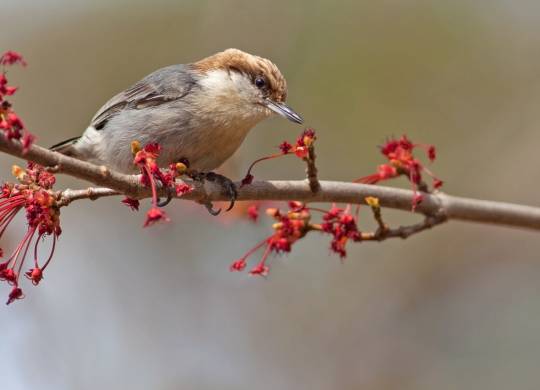
Brown-headed Nuthatch (Silla pusilla)
See, here's the real question about the eBird choices. Why choose the Bachman's Sparrow, when the adorably charismatic Brown-headed Nuthatch (Silla pusilla) was right there? The largest breeding population of this bird's global range is in Georgia, with a full 26% of the species depending on Georgia for its propagation. Yeah. This is definitely a Georgia breeder, but since the Bachman's Sparrow is a bit more endangered, has different living conditions, and is a bit more dependent on its Georgia population than the nuthatch here, that's likely why it was given the crown.
And yet...AND YET...in my opinion, this is the better state-dependent representative for Georgia. Sure, less of its breeding population is found in Georgia, but one-quarter of its global population isn't exactly something to sneeze at. And, importantly, this is where the majority of its population is housed, making Georgia more important for the Brown-headed Nuthatch than it is for the Bachman's Sparrow. But is it a better representative outside of that point? Well, it's recognizable, it's not terribly difficult to find, and it's certainly charismatic. I mean, look at that thing, it's cute as hell! Not that the sparrows aren't cute in their way, but the nuthatch? I wanna squeeze that thing, and apparently, they actually sound like rubber duckies. And no, charisma doesn't always mater, and it can be damaging for noncharismatic species conservation. But it can help.

Anything else? Well, using the same logic I have with other birds, it's an important representative of its habitat. The pine forests of the Southeastern USA are, unsurprisingly, in trouble. In fact, longleaf pine forests are kind of a massive deal from a conservation standpoint, and they're in a massive amount of trouble due to development and climate change. Some figures calculate a 95% loss of these forests by 2080, which is...bad, it's real bad, obviously. That kind of potential danger to their habitat, combined with their role within it, makes the nuthatch a good option. And apparently, Birds Georgia agrees with me.
Birds Georgia, for the record, is formerly known as the Georgia chapter of the National Audubon Society. And, while they still have affiliation to the organization, they've separated themselves from the legacy of its namesake. Credit where credit's due! Anyway, why bring them up? Birds Georgia has a number of species they highlight for conservation focus, with the Brown-headed Nuthatch being a major example. Their nestbox program focuses on building more nestboxes for a declining species across the state, and it's very much worked! 450 nest boxes have been installed across the state since 2015, and hopefully that doesn't stop! So, cute potential representative! But that's not the only conservation focus from Birds Georgia.
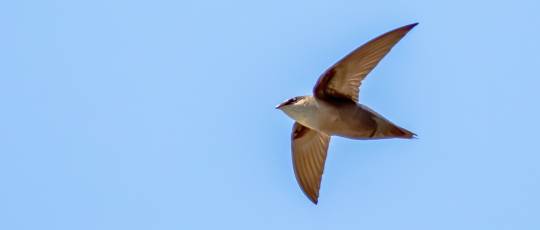
Chimney Swift (Chaetura pelagica)
From 2019 to 2020, Birds Georgia named the Chimney Swift their Conservation Focus for the year, and began an initiative to have nestboxes put out for the species across the state. Multiple towers were erected throughout the state by multiple conservation initiatives working with Birds Georgia, giving the birds more habitats outside of direct human settlements to breed and thrive in. But, why the Chimney Swift? They're sort of all over the place.
If you're from the eastern USA and walked outside in the morning or late afternoon, you've probably heard random chittering high above you, especially if you're in a city or town with chimneys on their buildings. If you look up, you've probably seen silhouettes of these guys flying at high speeds in the sky, mouths open to gather flying insects in the dawn and dusk. These are common birds all over the eastern US, as well as recognizable and easy to find and hear. So, why suggest them for Georgia? Because Georgia is tied with three other states for having the largest proportion of the breeding population for the species, at 6% of the species. Not a high number, but a significant proportion nonetheless. That makes it an intriguing choice for Georgia...and a few other places. So, this is probably not the last time we see this species on the polls.
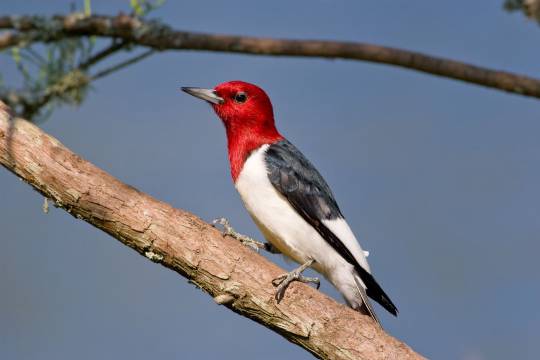
Red-headed Woodpecker (Melanerpes erythrocephalus)
But hey, if we're going for birds elevated by Birds Georgia, then we should probably highlight their actual mascot: the Red-headed Woodpecker (Melanerpe erythrocephalus). We've already talked about the importance of woodpeckers as keystone species in forested environments, and the Red-headed Woodpecker is definitely an example of that ecological role. In truth, the Pielated Woodpecker (Dryocopus pileatus), which was up for the Pennsylvania poll, actually widens holes made by the Red-headed Woodpecker for its own nest-cavities, meaning a keystone depends on a keystone.
Now, in terms of Georgia's population, the breeding population in the state is definitely not the bulwark for the species (that trophy belongs to Kansas with 11%), but the live oak forests the state is seeking to protect definitely houses the species in significant numbers state-wide. The reason Birds Georgia uses it in their logo is because, in 2014, the species was considered high-risk and on the decline in its range. As of 2022, the species is also suffering its highest region-wide decline in Georgia, tied with a few other states on that front well. Combine these facts with an iconic appearance, and the Red-headed Woodpecker is also a decent choice for State Bird from a conservation standpoint.
OK...one more. And this one's...a stretch.

Red-Shouldered Hawk (Buteo lineatus)
OK, it's not actually a stretch; I just wanted to say that because it's a tall image, and I thought it'd be funny. So, OK! The Red-shouldered Hawk (Buteo lineatus). Now, this is yet another species you can find in various places in the eastern USA, but its second largest breeding population in the country can be found in the Peach State, which is beat out by Florida. Trust me, though, Florida is one of the big three states in the South in terms of breeding bird populations. I try to get a raptor for each state, you'll notice, but why this raptor for Georgia, outside of the breeding population thing?
Well, firstly, there's the association of the species with swamps and woodlands, both of which are prominent Georgia habitats. They've got an extremely varied diet, going for most small prey items in their ranges, even weird ones like roadkill deer, crayfish, and screech owls. And while they're most common in Georgia, they're also most certainly seen in Georgia fairly commonly, especially after their recovery from DDT. But even then...why? Why have a hawk for the state of Georgia at...OK, some of you probably figured it out, I might as well just say it now.

Yup, Georgia's basketball team is the Atlanta Hawks. And yes, OBviously I could've gone for the Atlanta Falcons, but falcons make far less sense to highlight for the state, ironically. There are only three commonly seen species in the state, and none of them have Georgia as a major highlight of their breeding ranges. So, with that in mind, the Hawks seem like the team to highlight, and the best hawk for the state of Georgia is the Red-shouldered Hawk. With that said, is this really the best choice for Georgia's state bird? I mean...that's up to Georgians (and Tumblrites) to decide in the end.
So! An odd post, this one was. Some interesting choices in the end, but is this the most solid roster? Not sure. I have my guess as to the winner for this one, and honestly...it's not a bad choice if I'm right. But with that, it's time to leave it to you - the people! And the next time we have one of these posts, we'll be heading to a region and a state near and dear to me, personally. Time for the Nutmeg State, and the first state with a frequent flyer for a state bird!

See you next time, and happy birding!
#bird#birds#birding#birder#birders#birdwatching#bird watching#black birder#state bird#state bird initiative#georgia#birblr#birdblr#state birds initiative#brown thrasher#northern bobwhite#quail#bachman's sparrow#sparrow#swamp sparrow#savannah sparrow#brown-headed nuthatch#chimney swift#red headed woodpecker#red-shouldered hawk#hawk#atlanta hawks#bird tumblr#long post#poll
38 notes
·
View notes
Text

Top: a map of Atlanta from 1927, zoomed in on a section of South Downtown just southwest of Underground Atlanta, at the intersection of Forsyth Street and Trinity Avenue. Notice the dark blocks that show where buildings were.
Bottom: what's currently at this location. Notice that the buildings – most of them, anyway – are gone. Instead, we've got surface parking lots that stay empty most of the time. Five Points MARTA Station is out of view to the north, and Garnett Station is just barely out of view to the south.
Remember this when someone says that MARTA doesn't go anywhere. We haven't given rail a fighting chance to succeed in Atlanta, given the disused space around many stations. This should be a great urban place.
We can and must do better. This is a dramatic example but there are others as well, where we've allowed suburban levels of density to linger near our major investments in rail. Some progress has been made by way of MARTA' s transit oriented development program. Much more is needed.
18 notes
·
View notes
Text

Forsyth Park, Savannah GA on a late afternoon
30 notes
·
View notes
Text
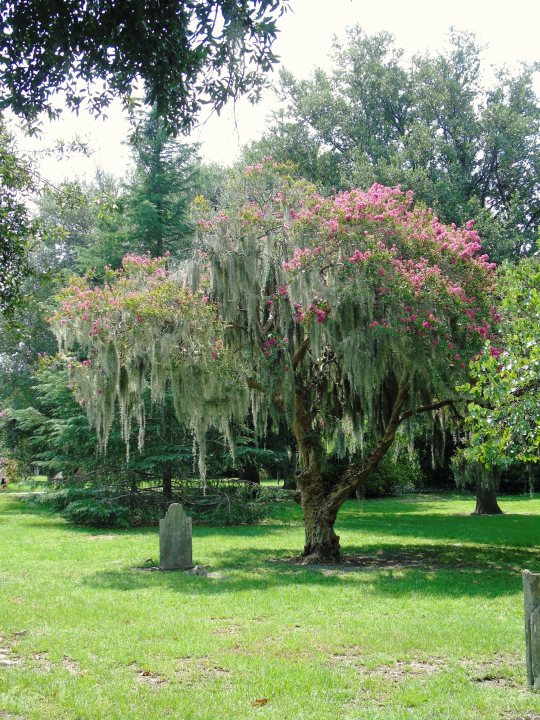





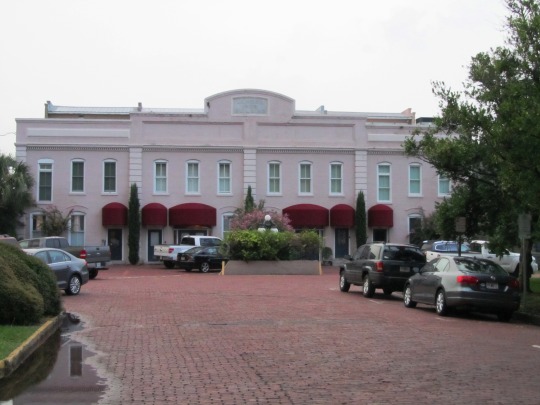





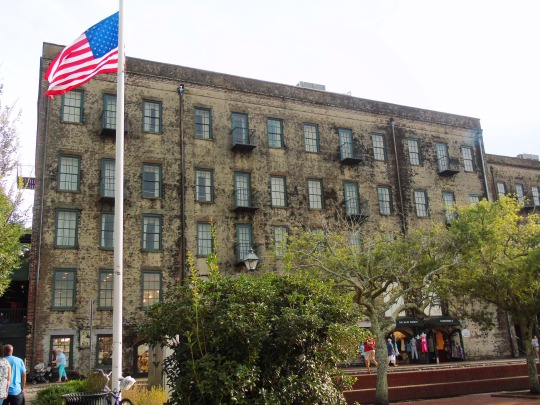



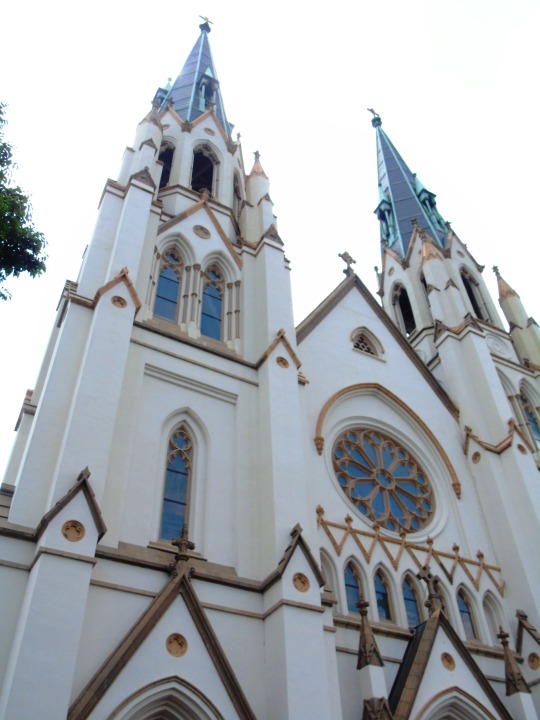
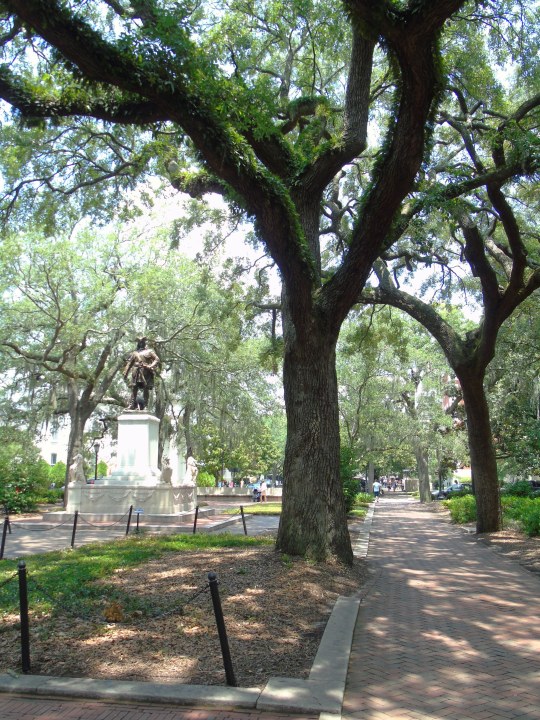
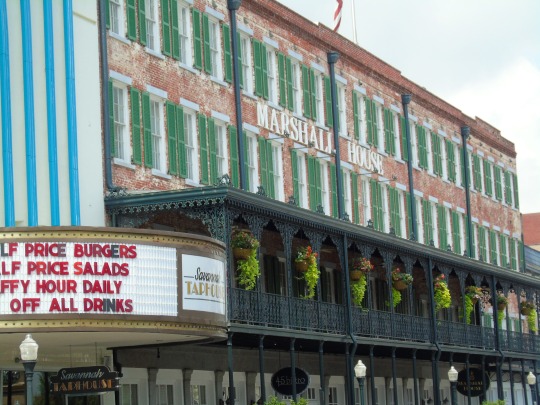



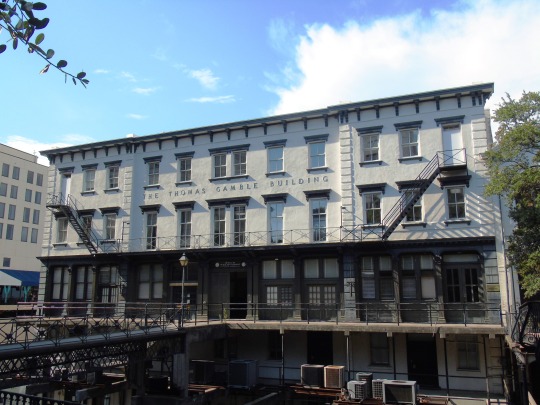


Englishman James Oglethorpe founded Savannah on February 12, 1733.
#Savannah#Savannah River#James Oglethorpe#founded#12 February 1733#USA#Georgia#summer 2016#2014#original photography#cityscape#travel#vacation#architecture#nature#flora#tourist attraction#landmark#Colonial Park Cemetery#Forsyth Park#Cathedral of St. John Baptist#City Hall#Chippewa Square#Savannah Cotton Exchange#2013#Granite Hall
2 notes
·
View notes
Text






This sweet little orange isn't so little anymore! ˗ˏˋ ꒰ 🍊🎂🍊 ꒱ ˎˊ˗
The Forsythes celebrated Clem's birthday by going to the park and throwing a very small party at home afterwards. It was a lovely day. ps mirabel loves dipping him in water for some reason
#sims 4#the sims 4#sims 4 gameplay#ts4 gameplay#ts4 legacy#sims 4 legacy#simblr#the sims community#sibg1#sims in bloom
19 notes
·
View notes
Text


When I was 21 years old, I met the best friend I'll ever have. I had my own place for the first time in my life, and for the past several months, I had been looking for a dog. My first dog that was just mine. I had gone to shelters and adoption events, and I had seen plenty of dogs. Adults and puppies, all different breeds, big and small. I didn't have any specifics for my new pet. But nobody I met had felt right.
One day, Nina and I walked into the puppy room at Young-Williams, a place we had been many times before that summer. And inside one of the pens was this little, jet black baby Anubis, a tiny, eight-pound puppy with big bat ears and long legs. He saw me, and he hopped up on his hind legs and jumped over and over, his forelegs extended.
He chose me.
Nina and I took him into the meet and greet room to spend more time with him, but in truth, I knew immediately: That little baby Anubis was MY DOG.
For the next 16 years, he was my constant companion, my copilot, my confidante. He was my shadow; we went everywhere together. When I moved to Savannah for grad school, moving further away from home than I'd ever lived, a city where the nearest person I knew was seven hours away, Oz was with me. We lived in a little apartment two blocks from Forsyth Park, and we learned the city together on long walks on cobblestone streets. When I was sad, he comforted me. When I was happy, he shared my joy. Anytime I reached out, he was there beside me.
Oz left me on Thursday evening. He stayed as long as he could. I did my best to give him a good sendoff. We had sushi in the park on his last day. He was tired, and I held him as he went to sleep, telling him how much I loved him and thanking him for choosing me and for loving me and for spending his life at my side.
I am sure Kif met him on the other side of the rainbow bridge. I feel like a part of me is missing. I feel like I've returned from a long, interstellar trip only to return to a planet that is nothing like the one I remember.
I would do it again. Knowing that I would end up like this, in this much pain, I would do it again. I would choose him every time. In every scenario, in every possible reality, I would choose him every time.
Oz
March 15, 2007 - July 6, 2023

30 notes
·
View notes
Text

It is difficult to read this thorough history of the bleached white shoe consulting firm McKinsey & Company and not wonder if the company’s continued, unreformed existence constitutes a public policy failure. The two New York Times’ reporters establish the company as a Forest Gump-like figure of American industry malfeasance; in the biggest moments of the domestic economy and industry buckling over the last century, McKinsey is frequently sitting somewhere in the background of the shot. The spread of Oxycontin? McKinsey advised Purdue Pharmaceutical. Deaths at Disney parks? McKinsey was brought in as an advisor. The astronomical explosion of CEO compensation packages, which has played a role in historic American wealth inequality? Yes, McKinsey was stalking in the background of this as well.
McKinsey is not the sole force for all that is bad in a modern economy that has produced more for those at the top of the economy at the expense of those below. But Forsyth and Bogdanich show us how “The Firm” can be thought of as an elite, special forces commando unit spearheading these trends before the corporate foot soldiers of the Fortune 500 follow closely behind. Things that companies maybe would have liked to do, but could not bring themselves to do, like launching mass layoffs in service of better bottom lines for shareholders, were shuffled along by McKinsey for a handsome fee initially fronted by C-suites, but paid, in the end, by the rest of us. —Ali Breland

Reading nonfiction books published before 2000 can be a numbing experience. They always seem to accurately predict our future and warn us of the dark path we’re on, and we seem to mostly ignore those warnings. I’ll look up from the page about worsening trends in inequality, or the troubling resurgence of white supremacists, and think about how I’m living in an inferno that was predicted 20 or 30 years ago. Barbara Ehrenreich’s entire corpus probably works like this, especially Fear of Falling, her 1989 history of the middle class and prophecy of its fall that deftly straddles the lines of academic thoroughness and readability. Even after 33 years, the book remains elucidating as it tracks how the avarice of the 1980s gutted the lower class and was starting to chip away at a then-solid middle class, and contextualizes the anxiety of a bourgeoisie that could already sense its fate. Ehrenreich, who passed away last year, helped show us that our reality is a constructed one, and that we are capable of constructing alternatives. Fear of Falling pairs well with her best-seller Nickel and Dimed, a first-person ethnography of the working poor, and her 2013 essay, “Death of A Yuppie Dream,” which updates her 1989 observations. —Ali Brelan
From Mother Jones
6 notes
·
View notes
